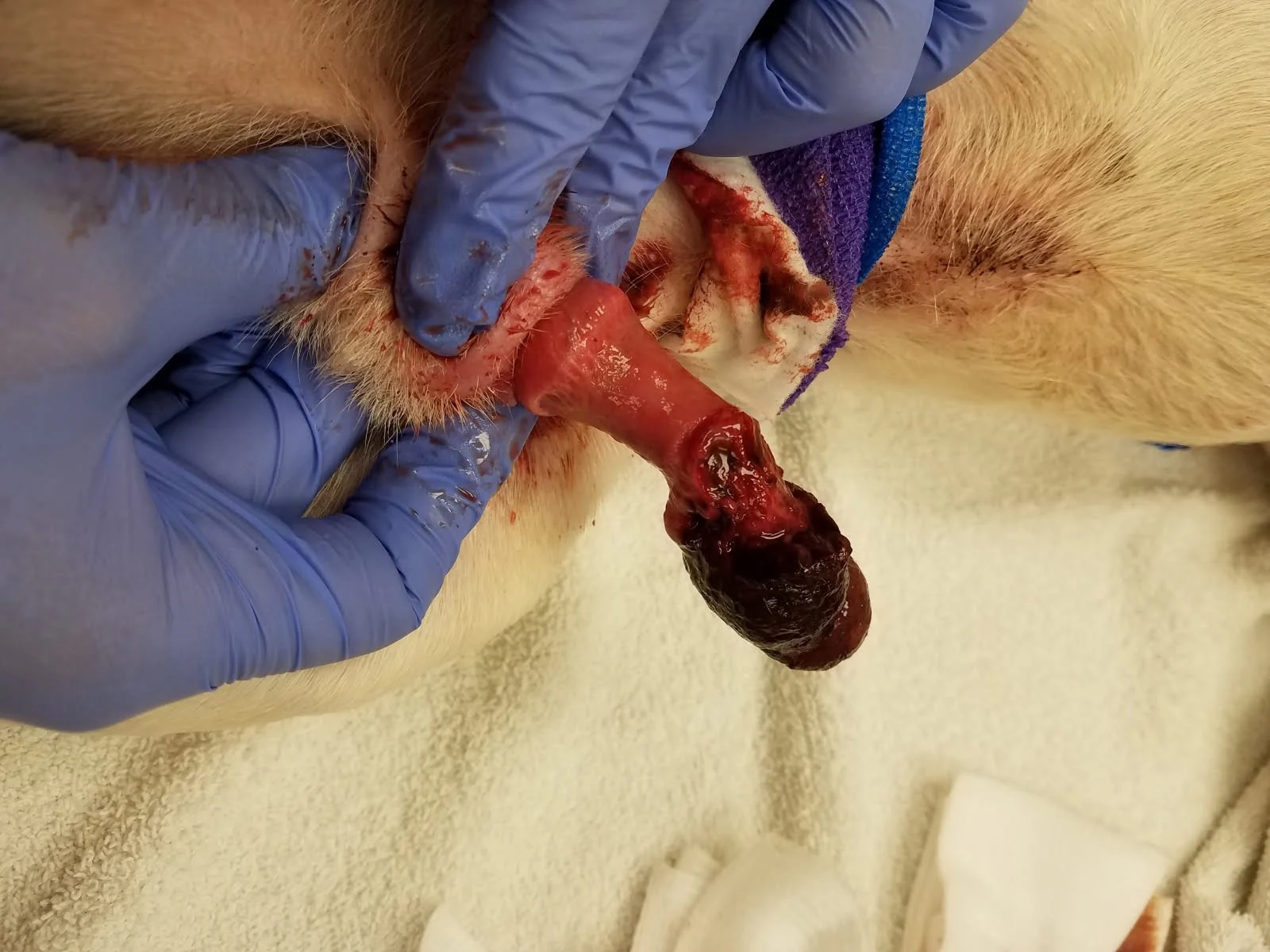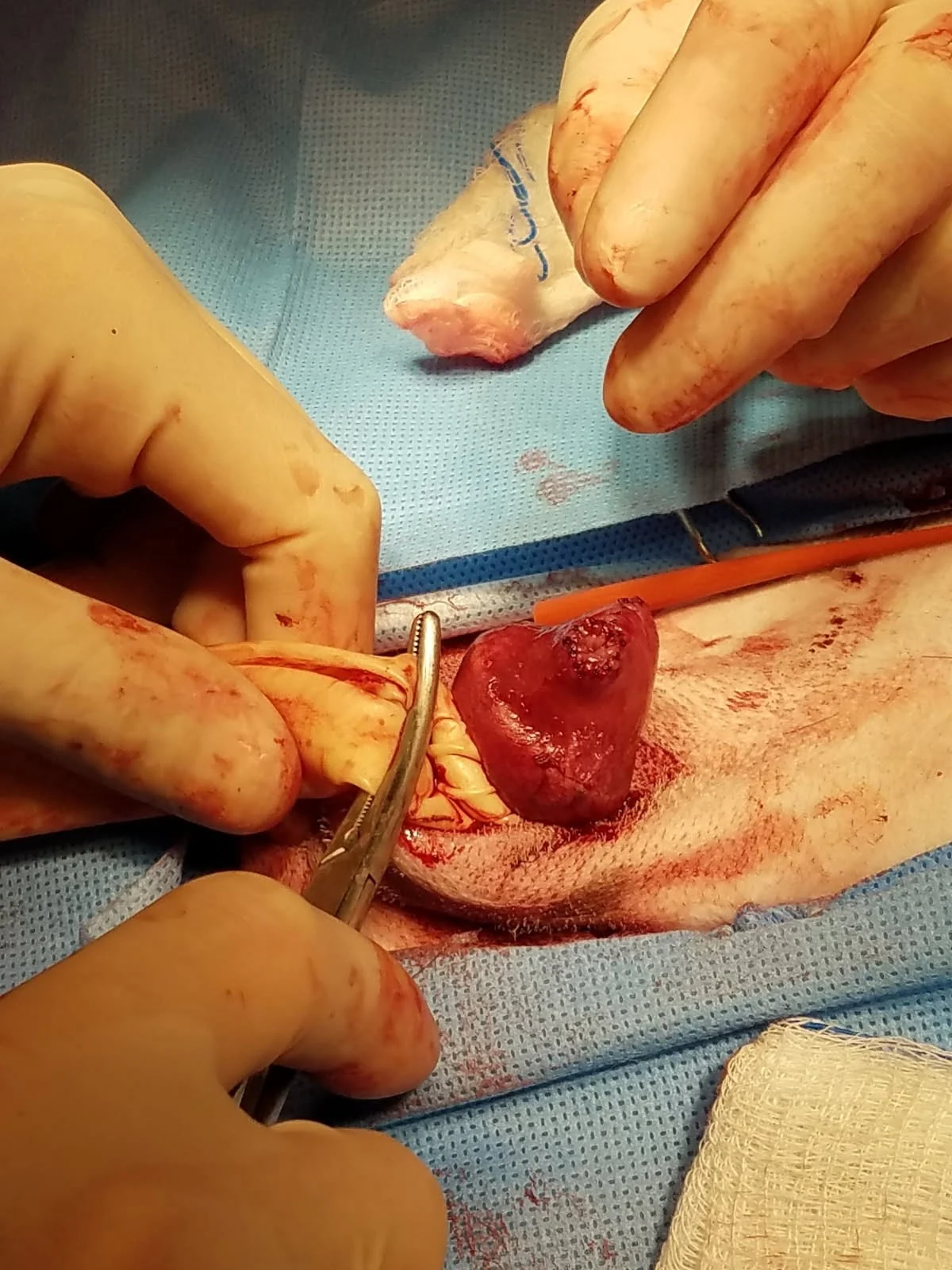
Rocky, an 18-month-old intact male French bulldog, was presented with an exposed penis of up to 3 days’ duration. Rocky had been housed in a kennel with multiple female dogs in estrus while his owner was out of town. On return, the owner noticed the tip of Rocky’s penis was exposed and appeared to be discolored.
Physical Examination
On physical examination, Rocky was bright, alert, and responsive. Vital parameters were within normal limits. The distal portion of the glans penis was swollen and dark in color. The penis was able to be fully extruded from the prepuce, revealing a line of visible demarcation between the discolored tissue and the bulbus glandis (Figure 1). On palpation, the distal penis was nonpainful, cool, and firm to the touch, with an ulcerated area believed to be the result of self-mutilation. Urination was functionally normal. On palpation, the testes and scrotum were within normal limits and nonpainful.

FIGURE 1 Exteriorized penis revealing the necrotic distal portion compared with the normal appearing mucosa of the proximal penis. Image courtesy of Carla Barstow, DVM, MS, DACT
Differential Diagnoses
Differentials for prolapsed penis in an intact male include paraphimosis (ie, inability to retract the nonerect penis into the preputial sheath) and priapism (ie, prolonged penile erection without sexual arousal).1 Priapism was eliminated because there was no evidence of erection at the time of examination.
Paraphimosis commonly occurs in unsupervised dogs when the penis is trapped outside of the prepuce following erection and may be due to preputial hypoplasia, presence of hair rings in long-coated breeds, foreign body, trauma, penile neoplasia, or neurologic disease.1,2 Rocky likely developed an erection during sexual excitement related to the presence of females in estrus, and the penis was trapped outside of the prepuce during detumescence. Of the aforementioned underlying factors, only self-induced trauma was present in this case. Devitalized tissue and self-mutilation indicated the condition had persisted >24 hours.
Diagnosis: Paraphimosis
Treatment & Long-Term Management
Because the protracted duration resulted in necrosis of the exposed tissue and subsequent mutilation, partial phallectomy and partial preputial resection were performed (Figure 2). An NSAID (carprofen, 2.2 mg/kg PO every 12 hours) for postoperative pain and swelling and an antibiotic (cefazolin, 22 mg/kg IM intraoperatively) were administered, and an Elizabethan collar was placed.

FIGURE 2 Penis following partial penile amputation to remove necrotic tissue and the devitalized distal portion of the glans penis. Image courtesy of Carla Barstow, DVM, MS, DACT
Castration is often performed during surgical correction but was not performed in this case because of the patient’s reproductive value. Castration alone does not correct paraphimosis.
Prognosis & Outcome
Paraphimosis was resolved, and only mild hematuria was noted postoperatively. Given the lack of underlying etiology, earlier identification would have likely resulted in a more favorable outcome.
Discussion
Paraphimosis is most often seen in young, intact male dogs but has also been reported in castrated males. Although this condition can occur secondary to several etiologies, including a congenitally small prepuce, trauma, stenotic preputial orifices, neoplasia, and neurologic defects in dogs with posterior paresis, 30% of cases are idiopathic.3
The entire length of the penis should be thoroughly examined to determine whether any other urogenital abnormalities are present. The normal prepuce should extend ≈1 cm cranial to the distal portion of the penis. A prepuce that terminates at the tip of the penis or is shorter than the penis can be suggestive of a hypoplastic prepuce that may need surgical correction.3
Early recognition and intervention are essential for preservation of penile function and vitality of the mucosa. With identification before tissue devitalization, especially in cases of hair entrapment or cases in which the prepuce rolls inward during detumescence, an attempt can be made to replace the penis into the prepuce using only water-soluble lubrication and gentle manipulation.1
Other therapeutic options include cold compresses and application of hyperosmolar agents (eg, mannitol, table sugar, honey, 50% dextrose) to draw water out of the penile tissues and facilitate replacement within the prepuce.2,4 Following manual replacement, oral anti-inflammatory medications can be administered and purse-string sutures can be placed at the opening of the prepuce to temporarily prevent recurrence. Intact males must be isolated from females in estrus and other possible causes of sexual excitement while penile tissue heals.1,2 An Elizabethan collar should be used to prevent excessive licking or self-mutilation, and tranquilizers can assist with recovery. In dogs not intended for breeding, progestogens (eg, megestrol acetate) may be considered to lower libido and prevent erection during the recovery process.1 Progestogens, however, are not typically prescribed in the United States because of potential adverse effects (eg, temperament changes, increased thirst or appetite, lactation, acromegaly) and lack of FDA-approved sources.
Treatment at a Glance
Complete evaluation of the entire length of the penis should be performed in all males presented for paraphimosis.
Cold compresses, water-based lubricants, and hypertonic solutions can be used initially to help decrease penile swelling and replacement in the sheath.
In long-coated dogs, preputial hair should be clipped to evaluate for presence of hair rings.
Most simple cases of paraphimosis can be corrected in the clinic without the need for surgical intervention.
Devitalized or mutilated tissue or chronic paraphimosis may require surgical resection for permanent correction.
Following surgical correction, an Elizabethan collar and tranquilizers should be used to decrease risk for incisional dehiscence and erection. In countries outside the United States, progestogens may be used to decrease libido during the postoperative period.
Although urination was not affected in this case, patients with trauma (eg, fractures of the os penis) may require a urinary catheter. Depending on the severity of clinical signs and whether the penis can be replaced in the prepuce, several surgical corrective options are available and described in the literature, including preputial lengthening, cranial preputial advancement, preputial muscle myorrhaphy, and phallopexy.3,5,6 In patients with severely damaged tissue, complete or partial penile amputation must be performed. In cases requiring complete penile amputation, urethrostomy should also be performed to facilitate urination.7 Numerous complications are associated with complete penile amputation7,8; partial penile amputation may therefore be a more desirable treatment option, especially in cases in which conserved reproductive potential is desired.
The overall incidence of surgical complications with partial penile amputation is low.8 In one study, major postoperative complications occurred in only 2 out of 10 patients that underwent partial penile amputation. Clinical signs, including stranguria and hematuria with secondary urethral scarring, occurred in 1 patient 2 weeks postoperatively. Another patient was presented 2 years postoperatively for revision after the penile mucosa became inflamed and traumatized secondary to long-term pruritus. Outcomes were determined to be good to excellent in 9 of the 10 dogs for which follow-up data were available.
Take Home Messages
Paraphimosis can occur in both intact and neutered males.
Early intervention is essential to prevent necrosis of exposed tissues.
Owners of breeding males should be instructed to check the prepuce and penis daily and be educated on how to replace the penis in the sheath via use of gentle manipulation and water-based lubricants.
Following correction, erection and ejaculation may be impaired in breeding males with prolonged paraphimosis.6
Castration of intact males may help facilitate resolution of recurrent paraphimosis but does not cure the condition.